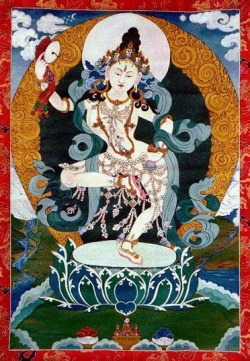WHAT IS A DAKINI? II
Dakini in Sanskrit, Khandro in Tibetan, literally means “sky dweller” or “sky dancer,” and is the most sacred aspect of the feminine principle in Tibetan Buddhism, embodying both humanity and divinity in feminine form.
Dakinis may appear differently in various contexts; when needed, she may appear as fierce and intense or playful and nurturing. At other times she may appear outrageous or repulsive in order to cut through conceptual thinking and mistaken perception. She may appear as a human being, as a goddess, either peaceful or wrathful, or she may be perceived as the general play of energy in the phenomenal world.
In general, the dakini represents the ever-changing flow of energy with which the yogic practitioner must work in order to become realized. Ultimately, all women are seen as some kind of dakini manifestation.
In her book Wisdom Rising, Lama Tsultrim states:
The dakini is a messenger of spaciousness and a force of truth, presiding over the funeral of self-deception. Wherever we cling, she cuts; whatever we think we can hide, even from ourselves, she reveals. The dakini traditionally appears during transitions: moments between worlds, between life and death, in visions between sleep and waking, in cemeteries and charnel grounds. (pg. 13)
Dakinis guard the most private details of spiritual practice, so that only those with the purest motivation are able to penetrate its essence. Without the blessing of the dakini, fruition of Vajrayana Buddhism is said to be impossible.
Often, the dakini appears when a spiritual practitioner is making the transition from an intellectual to an experiential approach. This is seen in the biography of Saraha:
The well known monk and scholar Saraha felt it was time to leave his university to go in search of a Tantric teacher. On the way he saw a young woman making arrows in a marketplace. He was fascinated by her and when he approached her and asked if she was a professional arrowsmith she replied: “My dear young man, the Buddha’s meaning can be known through symbols and actions, not through words and books.”
After this he understood the symbolic meaning of the arrow and then he began living with this low-caste women, accepting her as his teacher. This outraged the religious community as he had been a pure brahmin. The famous dohas of Saraha, his songs of realization, were his response to the king, the queen and the people, who challenged his religious understanding because he had gone to live with this dakini.
Finally, on an absolute level, the real wisdom dakini is the empty quality of luminous awareness. In this way, the great mother Dharmakaya is the basis for all the dakinis.

